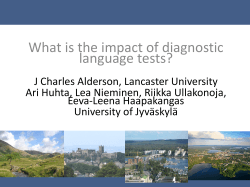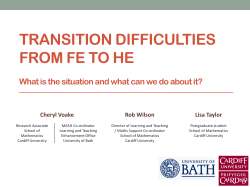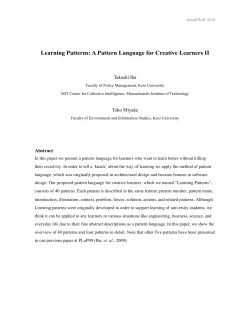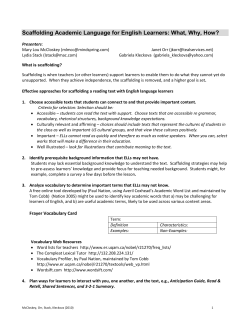
Examining washback: What do we know Dianne Wall
Examining washback: What do we know and what is there left to explore? Dianne Wall Lancaster University UK Definitions High-stakes tests Tests whose results are seen – rightly or wrongly – by students, teachers, administrators, parents or the general public, as being used to make important decisions that immediately and directly affect them. (Madaus, 1988) Definitions Impact Any of the effects that a high-stakes test may have on individuals, policies, or practices – within a classroom, a school, an educational system or society as a whole. (Wall 1997) Definitions Washback ... a type of impact, which relates to the effects of high-stakes tests on classroom practices – particularly teaching and learning. Types of washback … can be positive or negative, to the extent that it either promotes or impedes the accomplishment of educational goals held by learners and/or programme personnel. (Bailey, 1996) Positive washback If a test has positive washback, ‘there is no difference between teaching the curriculum and teaching to the test’. (Weigle & Jensen, 1997, p. 205) Negative washback - a mismatch between the stated goals of instruction and the focus of assessment, - may lead to the abandonment of instructional goals in favour of test preparation Outline • Development of the concept • Overview of research early studies overview of what we know now • Critical issues General education Positive views Tests can be a powerful, low-cost means of influencing the quality of what teachers teach and what learners learn at school. (Heyneman & Ransom, 1992) General education Positive views ‘measurement-driven instruction’ (MDI) If tests are ‘properly conceived and implemented’, then focusing teaching on what they assess is a beneficial activity. (Popham, 1987) General education Positive views Systemic validity …when a test induces in the education system curricular and instructional changes that foster the development of the cognitive skills that the test is designed to measure. (Fredericksen & Collins, 1989) General education Negative views ‘psychometric imperialism’ - Leads to cramming - Narrows the curriculum - Focuses the attention on skills that are easy to test - Restricts teacher and student creativity - Demeans the professional judgement of teachers … transfers control over the curriculum to the agency which sets or controls the exam. (Madaus, 1988) Views from language education If it is a good examination, it will have a useful effect on teaching; if bad, then it will have a damaging effect on teaching. (Heaton, 1990) - Aspirations - Assertions (little evidence) Foundation papers • • • • Alderson & Wall 1993 Hughes 1994 Bailey 1996 Messick 1996 Alderson & Wall 1993 • What washback is and what it is not • Need to be specific: Washback Hypotheses • Need to use a variety of methods when investigating – with emphasis on observation • Need to learn from research in other disciplines: e.g innovation theory, motivation theory Washback Hypotheses • • • • • • A test will influence teaching. A test will influence learning. A test will influence what teachers teach. A test will influence what learners learn. A test will influence how teachers teach. A test will influence how learners learn. Washback Hypotheses (continued) • A test will influence the rate and sequence, and the degree and depth of teaching. • A test will influence the rate and sequence, and the degree and depth of learning. • A test will influence attitudes to the content, method, etc … of teaching and learning. • Tests will have washback on all teachers and learners. or • Tests will have washback on some teachers and some learners but not on others. Hughes 1994 Need to look at washback on - Participants - Processes - Products Participants Teachers Learners Administrators Materials writers Curriculum designers Processes For teachers What they teach, how they teach, the intensity of their teaching, whether they give extra classes… For learners Practising the target language and skills, deciding what to study and what not to study, memorising, worrying, looking for shortcuts, cheating… Products New curricula? New timetables? New materials? Better learning? Bailey, 1999 Basic model of washback Messick 1996 Evidential link It is problematic to claim evidence of test washback if a logical or evidential link cannot be forged between the teaching or learning outcomes and the test properties thought to influence them. Messick 1996 Validity by design …rather than seeking washback as a sign of test validity, seek validity by design as a likely basis for washback. Messick 1996 Validity by design • • • • direct testing authenticity (input, tasks) avoid construct under-representation avoid construct-irrelevant variance Early research Wall & Alderson 1993 different amounts of washback – on content, methods, means of assessment Alderson & Hamp-Lyons 1996, Watanabe 1996 teachers are affected by tests in different ways Shohamy, Donitsa-Schmitt & Ferman, 1996 the washback of tests can change over time Areas where washback can appear (Spratt 2005) Curriculum contents of curriculum, timetabling Teaching materials choice of textbooks, use of past papers, teacher-made materials Teaching methods choice of methods, teaching of test-taking skills Attitudes and feelings of learners and teachers Learning Do test results improve? Does learning improve? Factors influencing washback (Spratt 2005) The exam -its proximity -its stakes -the status of the language it tests -its purpose -the formats it employs -the weighting of individual papers -when the exam was introduced -how familiar the exam is to teachers Teacher beliefs about - the reliability and fairness of the exam - what constitute effective teaching methods - how much the exam contravenes their current teaching practices - the stakes and usefulness of the exam - their teaching philosophy - the relationship between the exam and the textbook - their students’ beliefs Teachers’ attitudes towards - The exam - Preparation of materials for exam classes - Lesson preparation for exam classes Teachers education and training - Teachers’ own education and educational experience - The amount of general methodological training they have received - Training in teaching towards specific exams and in how to use exam-related textbooks - Access to and familiarity with exam support materials such as exam specifications - Understanding of the exam’s rationale or philosophy Resources - The availability of customised materials and exam support materials such as exam specifications - The types of textbooks available School - Its atmosphere - How much the administrators put pressure on teachers to achieve results - The amount of time and number of students in exam classes - Cultural factors such as learning traditions Recent investigations Teacher beliefs – Huang 2009 Washback on learners – Huhta, Kalaja, & Pitkänen-Huhta 2006 Tracing the evidential link – Wall & Horak 2006, 2008 and 2011 Critical issues • For teachers - How to find the right balance between teaching and exam preparation? • For exam developers – How to strengthen the influence of the exam when so many other factors affect teaching? • For testing community - Who should accept responsibility if an exam is mis-used, and has unintentional negative washback and impact? • For educational authorities – How to convince examination boards to do impact studies? Importance of washback studies EALTA Guidelines for Good Practice Considerations for test development in national or institutional testing units or centres 1. Is the test intended to initiate change(s) in the current practice? 2. What is the washback effect? What studies have been conducted? Survey on Impact Studies (Wall & Horak 2006) Survey of EALTA members via discussion list – Have you been involved in the introduction of a new exam or an examination reform? – What was the intended impact of the new/reformed exam? – Was an impact study of any sort conducted (however small)? – Methodology – who, when, what, how? Survey on Impact Studies Reasons given for not conducting an impact study • Lack of awareness of value ‘The new system is simply assumed to be a substantial improvement …’ • Lack of interest ‘…we can’t imagine who would have been interested in the results except perhaps ourselves.’ Reasons given for not conducting impact studies • Lack of expertise ‘…because there is no expertise available and there is not a scientific language testing tradition in the region.’ • Lack of time and energy ‘We knew it would be hard enough to introduce reforms; we did not have the time or energy to conduct any further tests of the kind you mentioned.’ Reasons given for not conducting impact studies • Lack of resources • Fear of results ‘Ministries are notoriously reluctant to let outsiders see if their measures have measurable outcomes.’ ‘…fear to stir the wasps’ nest – the reality might be too terrible.’ Why aren’t there more washback studies? Lack of • Awareness of the value • Interest • Expertise • Time and energy • Resources and • Fear of results Thanks, and over to you… d.wall@lancaster.ac.uk
© Copyright 2025









